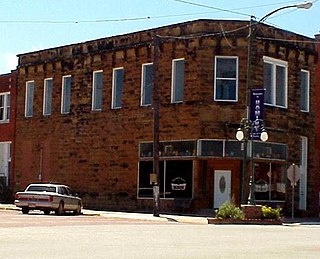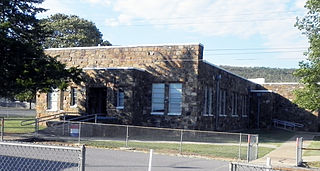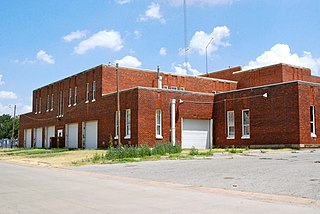Idabel Armory | |
 | |
| Location | Washington and SE Avenue F Sts., Idabel, Oklahoma |
|---|---|
| Coordinates | 33°53′43″N94°49′16″W / 33.89528°N 94.82111°W Coordinates: 33°53′43″N94°49′16″W / 33.89528°N 94.82111°W |
| Area | less than one acre |
| Built | 1936 |
| Architectural style | Romanesque, Vernacular Romanesque |
| MPS | WPA Public Bldgs., Recreational Facilities and Cemetery Improvements in Southeastern Oklahoma, 1935--1943 TR |
| NRHP reference # | 88001409 [1] |
| Added to NRHP | September 8, 1988 |
The Idabel Armory in Idabel, Oklahoma was built in 1936 as a Works Progress Administration (WPA) project. [1] It was listed on the National Register of Historic Places in 1988. [1]

Idabel is a city in and county seat of McCurtain County, Oklahoma, United States. The population was 7,010 at the 2010 census. It is located in the southeast corner of Oklahoma, a tourist area known as Kiamichi Country.

The Works Progress Administration was an American New Deal agency, employing millions of people to carry out public works projects, including the construction of public buildings and roads. It was established on May 6, 1935, by Executive Order 7034. In a much smaller project, Federal Project Number One, the WPA employed musicians, artists, writers, actors and directors in large arts, drama, media, and literacy projects. The four projects dedicated to these were: the Federal Writers’ Project (FWP), the Historical Records Survey (HRS), the Federal Theatre Project (FTP), the Federal Music Project (FMP), and the Federal Art Project (FAP). In the Historical Records Survey, for instance, many former slaves in the South were interviewed; these documents are of great importance for American history. Theater and music groups toured throughout America, and gave more than 225,000 performances. Archaeological investigations under the WPA were influential in the rediscovery of pre-Columbian Native American cultures, and the development of professional archaeology in the US.

The National Register of Historic Places (NRHP) is the United States federal government's official list of districts, sites, buildings, structures, and objects deemed worthy of preservation for their historical significance. A property listed in the National Register, or located within a National Register Historic District, may qualify for tax incentives derived from the total value of expenses incurred preserving the property.
It is a single-story building built of sandstone. Its main portion is 86 by 124 feet (26 m × 38 m) and it has two 30 by 92 feet (9.1 m × 28.0 m) wings. [2]

Sandstone is a clastic sedimentary rock composed mainly of sand-sized mineral particles or rock fragments.
Its NRHP nomination notes:
As a WPA building, the armory is notable primarily for its scale. That quality makes the structure significant within the community of Idabel, but more important is its type, materials of construction and character of workmanship. Equally significant is that the building itself contributed to a state of military preparedness which enabled the Oklahoma National Guard to contribute to the allied victory during World War II. Among other things, it contains an in-door rifle range. Construction of the armory likewise provided jobs for destitute workers at a point in the depression of the 1930s when there were none in the private sector, resulting in some economic security and greater self-esteem. [2]
















